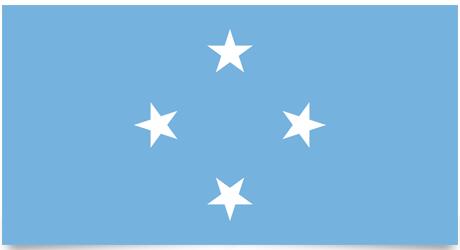Micronesia Flag and Meaning
Flag of Federated States of Micronesia

Micronesia Flag Meaning
Initially, the country was a UN mandate area and was the US Pacific Protectorate. Unlike the current flag of the Federated States of Micronesia, a similar one was used then, from 1962, but instead of four five-pointed stars, it had six stars. These stood for Palau, Chuuk (then Truk), the Marshall Islands, Yap, Pohnpei and the Northern Mariana Islands. The latter gained their own autonomy on April 1, 1976, and the reduction in the number of stars in the flag came about because Palau and the Marshall Islands chose not to be part of the Federated States of Micronesia.
The blue color is a symbol of the Pacific Ocean.
Micronesia Overview
| Population | 123000 |
| Currency | US $ |
| Area | 702 km² |
| Capital city | Palikir |
| Population density | 175.2 residents/km² |
| HDI location | 103 |
The total area of the country is spread over many islands and amounts to 2,500 km². About half of the area is on the island of Pohnpei (until 1984 called Ponape). The landscape is mountainous and the climate tropical with extensive rainfall. Along with the Caroline Islands – apart from Palau – the federation consists of 4 states: Yap (119 km²), Chuuk (until 1990 called Truk, 127 km²), Pohnpei (345 km²) and Kosrae (100 km²).
The People: Tzereesere 41.1%; ponytail 25.9%; mortar locks 8.3%; food cleaners 7.4%; yape people 6%; Woleians 4%, moksiles, 1.2% and others.
Religion: Christianity is dominant. The Kosraans, the Pohnpies and the Trukes are predominantly Protestants; the Yapses are predominantly Roman Catholic
Language: English (official). Local languages
Official Name: Federated States of Micronesia.
Administrative division: 4 states (Chuuk or Truk, Kosrae, Pohnpei and Yap)
Capital: Palikir, on the island of Pohnpei, 7,000 residents (2003).
Other important cities: Moen 23,900 in Chuuk (2000); Toll 10,000 residents; Colonia, 5,800 in Yap.
Government: Since May 2015, Peter Christian has been President, Head of State and Government. Parliament (Congress) has one chamber with 14 members, of which 10 are elected every 2 years and the remaining 4 have a 4 year term.
National Day: May 10 (Proclamation of Micronesia’s Federal States, 1979), November 3 (Independence, 1986)
Armed Forces: Defense is provided by the United States. Micronesia is a “Free and Independent State Associated with the United States in Defense”. The young people of Micronesia have the right to enroll in the United States military without hindrance.













































